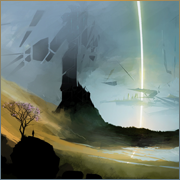- Adbot
-
ADBOT LOVES YOU
|

|
|
#
?
May 25, 2024 19:54
|
|
- aniviron
- Sep 11, 2014
-

|
Unfortunately, I think the Stellaris reference you're looking for is the one where you survey a toxic planet and it tells you that an industrial civilization doomed themselves by letting a runaway greenhouse effect gently caress up the planet in a fit of short-sightedness.
|
 #
?
Sep 27, 2022 03:14
#
?
Sep 27, 2022 03:14
|
|
- Rappaport
- Oct 2, 2013
-

|
American pig-dog aggression in peaceful outer space continues unabated. The so-called scientific arm of their military-industrial complex, "NASA", just rammed a space truckbike into an innocent asteroid 
https://twitter.com/NASA/status/1574574941348962326
quote:After 10 months flying in space, NASA’s Double Asteroid Redirection Test (DART) – the world’s first planetary defense technology demonstration – successfully impacted its asteroid target on Monday, the agency’s first attempt to move an asteroid in space.
Mission control at the Johns Hopkins Applied Physics Laboratory (APL) in Laurel, Maryland, announced the successful impact at 7:14 p.m. EDT.
As a part of NASA’s overall planetary defense strategy, DART’s impact with the asteroid Dimorphos demonstrates a viable mitigation technique for protecting the planet from an Earth-bound asteroid or comet, if one were discovered.
“At its core, DART represents an unprecedented success for planetary defense, but it is also a mission of unity with a real benefit for all humanity,” said NASA Administrator Bill Nelson. “As NASA studies the cosmos and our home planet, we’re also working to protect that home, and this international collaboration turned science fiction into science fact, demonstrating one way to protect Earth.”
DART targeted the asteroid moonlet Dimorphos, a small body just 530 feet (160 meters) in diameter. It orbits a larger, 2,560-foot (780-meter) asteroid called Didymos. Neither asteroid poses a threat to Earth.
[...]
These systems guided the 1,260-pound (570-kilogram) box-shaped spacecraft through the final 56,000 miles (90,000 kilometers) of space into Dimorphos, intentionally crashing into it at roughly 14,000 miles (22,530 kilometers) per hour to slightly slow the asteroid’s orbital speed. DRACO’s final images, obtained by the spacecraft seconds before impact, revealed the surface of Dimorphos in close-up detail.
|
 #
?
Sep 27, 2022 05:43
#
?
Sep 27, 2022 05:43
|
|
- Bug Squash
- Mar 18, 2009
-

|
Because I don't remember that being able to crash into the asteroid was the part we had many doubts about.
The really tricky bit wasn't the lithobraking, but the fact that it was mostly automated. The target is a tiny asteroid orbiting a slightly bigger one, and all we could see was a blur that contained them both. They had to write software that would allow the craft to target the small asteroid as it resolved in it's vision, and there was no guarantee that would work.
|
 #
?
Sep 27, 2022 08:48
#
?
Sep 27, 2022 08:48
|
|
- DrSunshine
- Mar 23, 2009
-

Did I just say that out loud~~?!!!
|
I wonder if there could be any analysis done of the dust kicked up by the collision? Like what was done with that comet probe iirc.
|
 #
?
Sep 27, 2022 14:14
#
?
Sep 27, 2022 14:14
|
|
- Rappaport
- Oct 2, 2013
-

|
I wonder if there could be any analysis done of the dust kicked up by the collision? Like what was done with that comet probe iirc.
quote:6.2. Model Ejecta
The DART impact is expected to liberate a large amount of
surface material from Dimorphos as ejecta. Studies of the ejecta
provide the opportunity to make an estimate of [the momentum transfer efficiency] β if the ejecta
momentum can be measured sufficiently well. LICIACube will
have a flyby distance of 55 km, and its imagery, with a best
resolution of 1.4 m pixel−1 (Dotto et al. 2021), will be used to
determine near-field ejecta properties. LICIACube objectives
include multiple images at times and phase angles to allow
measurement of ejecta, with an emphasis on measuring ejecta
moving at <5 m s−1 (Dotto et al. 2021). The LICIAcube
images are designed to follow plume evolution in the first
300 s with both the Liciacube Explorer Imaging for Asteroid
(LEIA) and Liciacube Unit Key Explorer (LUKE) cameras.
With this sequence the dynamical characteristics and speed
distribution within the plume can be retrieved. Given the timing
of the LICIACube flyby (currently planned for 165 s after the
DART impact; Dotto et al. 2021), opportunities for plume
13
The Planetary Science Journal, 2:173 (24pp), 2021 October Rivkin et al.
imagery may be expected both inbound and outbound for
LICIACube.
Cheng et al. (2020) developed an ejecta model relevant to the
DART impact into Dimorphos and discussed how imagery can
be used to extract information about the impact conditions from
the ejecta plume, including using measurements of the plume
axis and asymmetry to estimate the ejecta momentum direction.
Ejecta mass and velocity distributions can be constrained from
the plume optical depth profile and evolution, which can then
be tied to physical properties like strength and porosity. The
Small Carry-on Impactor (SCI) experiment done by the
Hayabusa2 team was analyzed using data from the Deployable
Camera (DCAM3) in a similar fashion (Wada et al. 2021), and
members of the Hayabusa2 team are also part of the
international DART team to lend their experience.
Visualizations are being developed to generate simulated
LEIA and LUKE imagery, as well as larger-scale imagery more
relevant to astronomical observations, from ejecta models like
those in Yu et al. (2017; Yu & Michel 2018) and Cheng et al.
(2020). These involve translating the time-evolving 3D-spatial
number density field into plane-of-sky appearance. At this
writing, work is focusing on simple cases using spherical
particles and reasonable assumptions for particle SFD and
photometric properties. In the near-field, ejecta particles feel
the gravitational acceleration from both binary components,
positioned and oriented using the modeling of Full Two-Body
Problem (F2BP) dynamical evolution of the binary itself,
developed for DART-1 and DART-2 and also employed for
DART-4A. Particles also feel throughout near field and far field
both differential solar gravity acceleration (“solar tides”) and
solar radiation pressure (including Didymos and Dimorphos
shadowing in the near field). Particles are propagated without
tracking interparticle collisions or influencing the binary in any
way, so they are essentially treated as an ensemble of test
particles in the Restricted Full Three-Body Problem (RF3BP).
In order to quickly interpret data, a suite of simulated images
for nominal and off-nominal cases will be rendered prior to the
DART impact, along with a pipeline for generating those
images from input parameters, to allow real images to be
compared to the simulated cases and allow those cases that
match the data most closely to be used as bases for more
detailed modeling. Forward modeling of simulated images to
match data returned from LICIACube and astronomical
facilities (Section 6.4), with knowledge of the topography
and geology near the site of DART’s impact (Section 6.3), will
allow estimation of particle properties that fit the evolving
ejecta plume, which in turn will inform our understanding of
Dimorphos’s surface properties.
6.3. Determine and Characterize the Impact Site, Refine
Dimorphos Shape, Determine Didymos Properties, and Image
the Impact Results
The imaging acquired by DRACO (prior to impact) and
LICIACube (both before and after impact) will enhance
understanding of the DART impact and its consequences on
momentum transfer. The data collected by DART will be used
by the Proximity Working Group to address several objectives:
1. Identify the impact location. The location of the impact
site and its relation to the center of figure of Dimorphos
will be determined via the Dimorphos shape modeling
effort supporting DART-4A. Current estimates suggest
that the impact point will be known relative to the center
of figure observed by the DRACO images to <50 cm;
radial errors from the center of Dimorphos parallel to the
DART velocity vector will be larger (<3.8 m). LICIA-
Cube images, which provide stereo parallax data, reduce
the radial error; ongoing efforts are characterizing the
magnitude of this error reduction.
2. Assess the target properties. DRACO images will be
used to assess the local target conditions at the impact
site. Particular attention will be paid to whether the
DART spacecraft impacted a block or regolith, and if any
large blocks or other topography nearby may have
influenced the excavation of debris from the impact.
Impact simulations (Barnouin-Jha et al. 2003; Syal et al.
2016; Susorney et al. 2017) and experiments (Güttler
et al. 2012; Tatsumi & Sugita 2018; Barnouin et al.
2019b), including those in situ at Ryugu (Arakawa et al.
2020; Wada et al. 2021), have shown that surface
properties can have a substantial effect on the excavation
process and resulting momentum transfer. LICIACube
has color imaging capability via its LUKE camera, which
can provide evidence of or upper limits to color variations
across the surface of Dimorphos and between Dimorphos
and Didymos at resolutions as fine as 4.3 m pixel−1 in the
nominal flyby case (Dotto et al. 2021). These data in turn
provide insight into the homogeneity of these objects in
terms of their composition and/or level of space
weathering.
3. Characterize the impact crater. LICIACube will attempt
to image the DART impact location. If ejecta do not
obscure the surface, the images will be used to
characterize the DART impact crater. The Proximity
Imaging Working Group will analyze the LICIACube
images and, by comparison to pre-impact DRACO
images, will determine some of the characteristics of
the crater, including diameter, depth, and shape, with the
caveat that the crater may not have completed forming
when it is still resolvable by the LICIACube cameras.
Evidence from the Haybusa2 Small Carry-On Impactor
(SCI) experiment at Ryugu (Arakawa et al. 2020) and the
Touch-And-Go event at Bennu indicates that near-
cohesionless surface conditions may be possible on
rubble-pile asteroids, and as a consequence very long-
lived crater excavation in the weak-gravity regime may
occur on Dimorphos.
4. Characterize the ejecta. LICIACube will image the
DART impact and provide constraints on the resulting
ejecta, including the ejecta plume angle, and debris
distribution.
The mission seems to be focused on the dynamics of the ejected rubble than say chemical composition, which makes sense given the goals. I'm not sure if this answers your question, sorry!
|
 #
?
Sep 27, 2022 14:35
#
?
Sep 27, 2022 14:35
|
|
- DrSunshine
- Mar 23, 2009
-

Did I just say that out loud~~?!!!
|
The mission seems to be focused on the dynamics of the ejected rubble than say chemical composition, which makes sense given the goals. I'm not sure if this answers your question, sorry!
That makes sense given it's primarily to study how the asteroid moves after it impacts, but I figured it'd be possible to study its composition and learn more about the conditions of the early solar system too!
|
 #
?
Sep 27, 2022 14:37
#
?
Sep 27, 2022 14:37
|
|
- Rappaport
- Oct 2, 2013
-

|
That makes sense given it's primarily to study how the asteroid moves after it impacts, but I figured it'd be possible to study its composition and learn more about the conditions of the early solar system too!
You'd have to lug along various spectrometers and the like, and they probably had to use up most of their weight budget on the collider itself, again for somewhat obvious reasons.
|
 #
?
Sep 27, 2022 14:39
#
?
Sep 27, 2022 14:39
|
|
- Pendevil
- Jun 18, 2007
-

|
Tell em the dinosaurs say hello.
|
 #
?
Sep 27, 2022 19:21
#
?
Sep 27, 2022 19:21
|
|
- dr_rat
- Jun 4, 2001
-

|
Anyway seems NASA's busy this week. Flyby of Europa in half an hour!:
https://www.youtube.com/watch?v=XwDUhTliPYA
|
 #
?
Sep 29, 2022 10:10
#
?
Sep 29, 2022 10:10
|
|
- Libluini
- May 18, 2012
-

I gravitated towards the Greens, eventually even joining the party itself.
The Linke is a party I grudgingly accept exists, but I've learned enough about DDR-history I can't bring myself to trust a party that was once the SED, a party leading the corrupt state apparatus ...
-
Grimey Drawer
|
Specifically, it's not just the expansion of the universe, but the acceleration of that expansion due to dark energy. According to this paper, the timescale for everything outside the Local Supercluster to redshift by a factor of 5000 is about 150 billion years (the cosmic microwave background today is at about z~1100). By about 2 trillion years from now, even the highest-energy gamma rays from the universe outside are redshifted to a wavelength longer than the size of the observable universe at that time, and therefore become completely unobservable.
That paper describes the Local Supercluster, not the Local Group; I'm not actually sure which is right, since from my non-cosmologist understanding the Local Supercluster is not actually gravitationally bound in the same way the Local Group is.
I actually remember reading about this in Scientific American a few years back. While it's true that the local supercluster isn't bound "the same way" as our local group, it's still influencing each other.
The cosmological explanation was something along the line of voids (zones between the superclusters) getting emptier and non-voids (those clumpy cluster areas) tend to attract more matter. Over a very long timespan, this would mean that galaxies in voids would slowly drift out of them into the clumpy areas, making them more dense, while the opposite doesn't happen. Imagine the combined gravity of a non-void acting as some form of sinkhole. Voids don't have enough galaxies to keep together, and really will have individual galaxies drift more and more apart.
Of course, dislaimer: I'm just an idiot who reads scientific articles, not a cosmologist. That poo poo should still be findable if you search for "voids" on their website.
Mister Lem was very pessimistic when it came to all things Fermi paradox, and a good chunk of his work revolves around the futility of even trying to contact anybody else. As our civilization turns away from a technology race around the cold war and instead a technology race towards better particle effects for block matching games for individuals to play while defecating, I'm beginning to share his attitudes towards ever meeting any cool space dudes 
That's certainly an attitude that's old as gently caress by now. Even in the early 60s, the explanation for why the alien battlecruiser who gave humanity access to the universe in the German series Perry Rhodan was that most of the crew didn't care about their jobs. Instead they played video games all day, not even getting up to do maintenance. Though back then video games weren't a thing, so the authors called them "fictitious games" instead.
|
 #
?
Sep 29, 2022 11:17
#
?
Sep 29, 2022 11:17
|
|
- Rappaport
- Oct 2, 2013
-

|
That's certainly an attitude that's old as gently caress by now. Even in the early 60s, the explanation for why the alien battlecruiser who gave humanity access to the universe in the German series Perry Rhodan was that most of the crew didn't care about their jobs. Instead they played video games all day, not even getting up to do maintenance. Though back then video games weren't a thing, so the authors called them "fictitious games" instead.
Which, that digital entertainment is a convenient distraction while the Earth slowly gets set on fire around humanity, or that alien intelligences in general have their own reasons for not trying to contact cosmic neighbours? Because I don't think either of those are very 60's.
|
 #
?
Sep 29, 2022 12:17
#
?
Sep 29, 2022 12:17
|
|
- Libluini
- May 18, 2012
-

I gravitated towards the Greens, eventually even joining the party itself.
The Linke is a party I grudgingly accept exists, but I've learned enough about DDR-history I can't bring myself to trust a party that was once the SED, a party leading the corrupt state apparatus ...
-
Grimey Drawer
|
Which, that digital entertainment is a convenient distraction while the Earth slowly gets set on fire around humanity, or that alien intelligences in general have their own reasons for not trying to contact cosmic neighbours? Because I don't think either of those are very 60's.
Neither, it's the third one: Digital entertainment as a distraction for aliens while their space empire slowly gets set on fire around them.
It's essentially a story showing us a mirror of what could be. (And then actually became reality, just that we didn't even manage to make a space empire first before falling on our faces.)
|
 #
?
Sep 29, 2022 12:33
#
?
Sep 29, 2022 12:33
|
|
- Heck Yes! Loam!
- Nov 15, 2004
-

a rich, friable soil containing a relatively equal mixture of sand and silt and a somewhat smaller proportion of clay.
|
The DART mission did way better than expected
https://www.youtube.com/watch?v=na1mlZj025c
|
 #
?
Oct 13, 2022 19:27
#
?
Oct 13, 2022 19:27
|
|
- DrSunshine
- Mar 23, 2009
-

Did I just say that out loud~~?!!!
|
Been a while since anyone posted anything here! Well, JWST is performing better than expected at seeing what's in exoplanet atmospheres. We've detected atmospheric chemistry!
https://www.sciencealert.com/we-just-got-the-most-detailed-view-of-an-exoplanet-atmosphere-yet-and-its-active
quote:
WASP-39b, a gas giant about 700 light-years away, is turning out to be quite the exoplanetary treasure.
Earlier this year, WASP-39b was the subject of the first-ever detection of carbon dioxide in the atmosphere of a planet outside the Solar System.
Now, an in-depth analysis of data from the James Webb Space Telescope (JWST) has given us an absolute goldmine of information: the most detailed look at an exoplanet atmosphere yet.
The results include information about WASP-39b's clouds, the first-ever direct detection of photochemistry in an exoplanet atmosphere, and a nearly complete inventory of the atmosphere's chemical contents that reveals tantalizing hints of the exoplanet's formation history.
These epic discoveries have been published in five papers in Nature, and pave the way for the eventual detection of the chemical signatures of life outside the Solar System.
"These early observations are a harbinger of more amazing science to come with JWST," says astrophysicist Laura Kreidberg, director of the Max Planck Institute for Astronomy in Germany.
"We put the telescope through its paces to test the performance, and it was nearly flawless – even better than we hoped."
Since the first exoplanets were discovered in the early 1990s, we've sought to know more about these worlds orbiting alien stars.
But the challenges have been steep ones. Exoplanets can be extremely small and are extremely distant. We've never even seen most of them: We only know of their existence based on the effect they have on their host stars.
One of these effects occurs when the exoplanet passes between us and the star, an event known as a transit. This causes the starlight to slightly dim; periodic dimming events suggest the presence of an orbiting body. We can even tell how big that orbiting body is, based on the dimming and gravitational effects on the star.
And there's something else we can tell, based on transit data. As starlight passes through the atmosphere of the transiting exoplanet, it changes. Some wavelengths on the spectrum are dimmed or brightened, depending on how molecules in the atmosphere absorb and re-emit light.
The signal is faint, but with a powerful enough telescope, and a stack of transits, the changing absorption and emission features on the spectrum can be decoded to determine the contents of an exoplanet's atmosphere.
JWST is the most powerful space telescope ever launched. With three of its four instruments, it obtained detailed infrared spectra from the star WASP-39. Scientists then got to work analyzing the colorful codes.
First up was a census of the molecules present in WASP-39b's atmosphere. In addition to the aforementioned carbon dioxide, the researchers detected water vapor, sodium, and carbon monoxide. There was no detection made of methane, implying that the metallicity of WASP-39b is higher than that of Earth.
The abundance of these elements is also revealing. In particular, the ratio of carbon to oxygen suggests that the exoplanet formed much farther from its host star than its current close-in position, occupying a four-day orbit. And modeling and observation data suggest that the exoplanet's sky is populated by broken clouds – not of water, but of silicates and sulfites.
Finally, the observations revealed the presence of a compound called sulfur dioxide. Here in the Solar System, on rocky worlds such as Venus and Jovian moon Io, sulfur dioxide is the result of volcanic activity. But on gas worlds, sulfur dioxide has a different origin story: It's produced when hydrogen sulfide is broken down by light into its constituent parts, and the resulting sulfur is oxidized.
Photon-induced chemical reactions are known as photochemistry, and they have implications for habitability, the stability of an atmosphere, and the formation of aerosols.
WASP-39b, to be clear, is not likely to be habitable to life as we know it for a whole bunch of reasons, including but not limited to its scorching temperature and gaseous makeup, but the detection of photochemistry is one that has implications for atmospheric studies of other worlds, and understanding the evolution of WASP-39b itself.
Planetary scientists have been gearing up for years for the insights into atmospheres that JWST was expected to provide. With the first detailed exoplanet atmosphere analysis, it seems that the space telescope is going to live up to its promise.
In addition, the teams involved in this research are preparing documentation so other scientists can apply their techniques to future JWST exoplanet observations.
We may not detect the signatures of life in an exoplanet atmosphere with JWST – perhaps an even more powerful telescope will be required to deliver that level of fine detail – but with the analysis of WASP-39b, that discovery is feeling ever more tantalizingly within grasp.
"Data like these," says astronomer Natalie Batalha of the University of California Santa Cruz, "are a game changer."
The research will be published Nature and can be read in preprints here, here, here, here, and here.
|
 #
?
Nov 27, 2022 15:56
#
?
Nov 27, 2022 15:56
|
|
- Rappaport
- Oct 2, 2013
-

|
Apparently the large-scale cosmos has a parity violation in its structure, or in other words, the universe has a ~*cosmic*~ handedness. 
Quanta Magazine posted:Asymmetry Detected in the Distribution of Galaxies
Two new studies suggest that certain tetrahedral arrangements of galaxies outnumber their mirror images, potentially reflecting details of the universe’s birth. But confirmation is needed.
Physicists believe they have detected a striking asymmetry in the arrangements of galaxies in the sky. If confirmed, the finding would point to features of the unknown fundamental laws that operated during the Big Bang. [...] As if playing a cosmic game of Connect the Dots, the researchers drew lines between sets of four galaxies, constructing four-cornered shapes called tetrahedra. When they had built every possible tetrahedron from a catalog of 1 million galaxies, they found that tetrahedra oriented one way outnumber their mirror images. A hint of the imbalance between tetrahedra and their mirror images was first reported by Oliver Philcox, an astrophysicist at Columbia University in New York, in a paper published in Physical Review D in September. In an independent analysis conducted simultaneously that’s now undergoing peer review, Jiamin Hou and Zachary Slepian of the University of Florida and Robert Cahn of Lawrence Berkeley National Laboratory detected the asymmetry with a level of statistical certainty that physicists usually consider definitive.
But with such a blockbuster finding — and one that’s still under review — experts say caution is warranted. “There’s no obvious reason that they’ve made a mistake,” said Shaun Hotchkiss, a cosmologist at the University of Auckland. “That doesn’t mean that there isn’t a mistake.” The putative imbalance violates a symmetry called “parity,” an equivalence of left and right. If the observation withstands scrutiny, physicists think it must reflect an unknown, parity-violating ingredient in the primordial process that sowed the seeds of all the structure that developed in our universe. “It’s an incredible result — really impressive,” Kamionkowski said. “Do I believe it? I’m going to wait to really celebrate.”
[...]
At or near the time of the universe’s birth, a field known as the inflaton is thought to have permeated space. A roiling, boiling medium where inflaton particles continuously bubbled up and disappeared, the inflaton field was also repulsive; for the brief time it may have existed, it would have caused our universe to rapidly expand to 100 trillion trillion times its original size. All of those quantum fluctuations of particles in the inflaton field were flung outward and frozen into the cosmos, becoming variations in the density of matter. The denser pockets continued to gravitationally coalesce to produce the galaxies and large-scale structure we see today. In 1999, researchers including Kamionkowski considered what would happen if more than one field was present before this explosion. The inflaton field could have interacted with another field that could produce right-handed and left-handed particles. If the inflaton treated right-handed particles differently than the left-handed ones, then it could have preferentially created particles of one handedness over the other. This so-called Chern-Simons coupling would have imbued the early quantum fluctuations with a preferred handedness, which would have evolved into an imbalance of left-handed and right-handed tetrahedral arrangements of galaxies.
As for what the additional field might be, one possibility is the gravitational field. In this scenario, a parity-violating Chern-Simons interaction would occur between inflaton particles and gravitons — the quantum units of gravity — which would have popped up in the gravitational field during inflation. Such an interaction would have created a handedness in the density variations of the early universe and, consequently, in today’s large-scale structure. In 2006, Stephon Alexander, a physicist now at Brown University, suggested that Chern-Simons gravity could also potentially solve one of the biggest mysteries in cosmology: why our universe contains more matter than antimatter. He surmised that the Chern-Simons interaction could have yielded a relative abundance of left-handed gravitons, which would in turn preferentially create left-handed matter over right-handed antimatter.
[...]
The team found a “seven-sigma” level of parity violation in the real data, meaning that the imbalance between left- and right-handed tetrahedra [of galaxies] was seven times as large as could be expected from random chance and other conceivable sources of error. [...] Philcox used similar methods (and had co-authored some earlier papers proposing such an analysis with Hou, Slepian and Cahn), but he made some different choices — for example, grouping the galaxies into fewer layers than Hou and colleagues, and omitting some problematic tetrahedra from the analysis — and therefore found a more modest 2.9-sigma violation of parity. The researchers are now studying the differences between their analyses. Even after extensive efforts to understand the data, all parties remain cautious.
[...]
First physicists need to verify (or falsify) the observation. New, ambitious galaxy surveys on which to repeat the analysis are already underway. The ongoing Dark Energy Spectroscopic Instrument survey, for instance, has logged 14 million galaxies so far and will contain more than 30 million when it’s completed. “That’ll give us an opportunity to look at this in much greater detail with much better statistics,” said Cahn. Moreover, if the parity-violating signal is real, it could show up in data other than the distribution of galaxies. The oldest light in the sky, for example — a bath of radiation known as the cosmic microwave background, left over from the early universe — provides our earliest snapshot of spatial variations in the cosmos. The dappled pattern of this light should contain the same parity-violating correlations as the galaxies that formed later. Physicists say it should be possible to find such a signal in the light. Another place to look will be the pattern of gravitational waves that may have been generated during inflation, called the stochastic gravitational wave background. These corkscrew-like ripples in the space-time fabric can be right-handed or left-handed, and in a parity-preserving world, they would contain equal amounts of each. So if physicists manage to measure this background and find that one handedness is favored, this would be an unambiguous, independent check of parity-violating physics in the early universe.
Do any of our cosmology-oriented posting pals have any opinions or insights into this?
|
 #
?
Dec 6, 2022 08:47
#
?
Dec 6, 2022 08:47
|
|
- Zoph
- Sep 12, 2005
-

|
I've only read the 1st one & only vaguely remember it, wasn't that something to do with escaping a war by going to a universe with less dimensions?
If I recall correctly the idea is a malevolent civilization fucks with our instruments from afar so we get confusing conflicting information about the nature of things and we're caught off guard when they invade.
Zoph fucked around with this message at 21:07 on Dec 6, 2022
|
 #
?
Dec 6, 2022 20:56
#
?
Dec 6, 2022 20:56
|
|
- Libluini
- May 18, 2012
-

I gravitated towards the Greens, eventually even joining the party itself.
The Linke is a party I grudgingly accept exists, but I've learned enough about DDR-history I can't bring myself to trust a party that was once the SED, a party leading the corrupt state apparatus ...
-
Grimey Drawer
|
Apparently the large-scale cosmos has a parity violation in its structure, or in other words, the universe has a ~*cosmic*~ handedness. 
Do any of our cosmology-oriented posting pals have any opinions or insights into this?
The cosmos being asymmetric is nothing new, there's also the anti-matter problem: That if anti-matter and matter had been created by the Big Bang in equal numbers, the universe would now only be filled with energy and nothing else. But for some reason there was slightly more matter ejected by the Big Bang, so some tiny amounts of matter were left over to form what we see today. But the question why the early universe contained less anti-matter than matter is an unsolved riddle.
Also, anti-matter and matter aren't the total mirrors they're supposed to be, anti-particles and particles behave very slightly differently, which drives physicists nuts.
The left-over matter turning out to be kind of chunky does not surprise me at all.
|
 #
?
Dec 6, 2022 22:19
#
?
Dec 6, 2022 22:19
|
|
- Coldbird
- Jul 17, 2001
-

be spiritless
|
Would energy have condensed into matter at some point? I have no idea about all this buck wild poo poo.
Best I understand it, to some extent yes, this could happen with some amount of energy - but it should have “condensed” into equal parts matter and antimatter, which should have still all annihilated. While we cannot absolutely rule out the possibility that the universe is organized into separate matter and antimatter galaxies and star systems - we wouldn’t be able to tell at a distance unless two were actively colliding - it’s considered extremely unlikely that any significant amount of antimatter exists naturally at this point.
Last I heard there was some indication that there was some inconsistency in the way the weak nuclear force interacts with the quarks that make up matter vs. the quarks that make up antimatter. That may be the reason for the big question of why the matter universe exists at all, or it may be something else entirely.
The Australian guy on SciShow proposed that, since antimatter is essentially the same as matter but viewed while going backwards in time, that maybe there’s no inconsistency at all - and the Big Bang created two universes; our matter universe, going forward in time, and an antimatter universe going backward in time.
Don’t know how much sense that makes, or if he was talking out of his rear end, but it was a fun idea
|
 #
?
Dec 6, 2022 23:28
#
?
Dec 6, 2022 23:28
|
|
- Boonoo
- Nov 4, 2009
-

ASHRAKAN!
Take your Thralls and dive back into the depths! Give us the meat and GO!
-
Grimey Drawer
|
They're very good books but a distressing amount of each is dedicated to finding the protagonist a girlfriend, and it's very much old sci-fi in the sense that they're very particular to the author moreso than any genre, if that makes any sense.
The second one especially. It has a pretty good payoff, though.
I think each book has a different feel and scope, but I enjoyed them all.
|
 #
?
Dec 7, 2022 00:37
#
?
Dec 7, 2022 00:37
|
|
- cat botherer
- Jan 6, 2022
-

I am interested in most phases of data processing.
|
Left handed best handed
|
 #
?
Dec 7, 2022 01:56
#
?
Dec 7, 2022 01:56
|
|
- Monglo
- Mar 19, 2015
-

|
So anyone knows if the recent claim of net positive fusion reaction holds any weight?
|
 #
?
Dec 12, 2022 20:51
#
?
Dec 12, 2022 20:51
|
|
- Libluini
- May 18, 2012
-

I gravitated towards the Greens, eventually even joining the party itself.
The Linke is a party I grudgingly accept exists, but I've learned enough about DDR-history I can't bring myself to trust a party that was once the SED, a party leading the corrupt state apparatus ...
-
Grimey Drawer
|
The Australian guy on SciShow proposed that, since antimatter is essentially the same as matter but viewed while going backwards in time, that maybe there’s no inconsistency at all - and the Big Bang created two universes; our matter universe, going forward in time, and an antimatter universe going backward in time.
Don’t know how much sense that makes, or if he was talking out of his rear end, but it was a fun idea
Stuff like this is always complete bullshit. I too can postulate nonsense-universes no-one can observe. In my universe that secretly spawned with ours during the BIg Bang, big bunnies with straws sucked out our anti-matter because they liked the taste. Since we can't observe any of this, it's as falsifiable as the dual-universe idea.
Even if literally real, it still doesn't work though, for the simple fact that going forward or backwards in time has no meaning, everything always moves towards entropy. True, you can flip the equations around, but this only works if you first assume everything now rolls backwards towards entropy. Which from our viewpoint would just be exactly the same as forward mode. Another point, we just found out anti-matter and matter are not exactly the same, which deflates this idea instantly.
It sounds like an awesome idea for a SF-story, though!
|
 #
?
Dec 12, 2022 21:12
#
?
Dec 12, 2022 21:12
|
|
- Libluini
- May 18, 2012
-

I gravitated towards the Greens, eventually even joining the party itself.
The Linke is a party I grudgingly accept exists, but I've learned enough about DDR-history I can't bring myself to trust a party that was once the SED, a party leading the corrupt state apparatus ...
-
Grimey Drawer
|
So anyone knows if the recent claim of net positive fusion reaction holds any weight?
I don't know about "net positive fusion reaction", as that was done a long time ago. Or are you thinking about the problem of nudging fusion reactors towards giving more electricity then they eat up? That's harder to do as long as we're just doing the basic "heat water, move thing, profit"-type of energy generation.
But yeah, recently it was found that the neutrons in the fusion plasma are a lot more energetic then assumed, and therefore the fusion plasma generates more energy. Before that can be useful it may be necessary to design a new generation of reactors, though: Apparently the fusion reactor were this was found already has cracks. The neutrons were a bit too energetic, it seems. 
|
 #
?
Dec 12, 2022 21:38
#
?
Dec 12, 2022 21:38
|
|
- Raenir Salazar
- Nov 5, 2010
-

-
College Slice
|
it's a known issue that the containment vessel for fusion reactions need to be made out of like an entirely new kind of material because of the neutron bombardment but thats something that will get more focus after research yields fruits about a sustainable fusion reaction; although there are plans to build new facilities to do the needed QA and research work on new reactor vessel materials.
There has been recent progress in material sciences, pretty promising ones in fact; a new facility is being built in the UK iirc to test a new tokamak reactor with new vastly lighter and more efficient magnets which is believed will vastly increase the yield/efficiency of the reaction.
|
 #
?
Dec 12, 2022 21:44
#
?
Dec 12, 2022 21:44
|
|
- Monglo
- Mar 19, 2015
-

|
Just to make it clear, I was referring to this.
https://www.nytimes.com/2022/12/12/science/nuclear-fusion-energy-breakthrough.html
They are making an official announcement on Tuesday.
Was curious if anyone itt had any details.
|
 #
?
Dec 12, 2022 21:53
#
?
Dec 12, 2022 21:53
|
|
- Conspiratiorist
- Nov 12, 2015
-

17th Separate Kryvyi Rih Tank Brigade named after Konstantin Pestushko
Look to my coming on the first light of the fifth sixth some day
|
Isn't there an energy thread?
|
 #
?
Dec 12, 2022 22:44
#
?
Dec 12, 2022 22:44
|
|
- Adbot
-
ADBOT LOVES YOU
|

|
|
#
?
May 25, 2024 19:54
|
|
- Raenir Salazar
- Nov 5, 2010
-

-
College Slice
|
You could argue its space relevant because fusion would be important for magnetoplasmic thrusters which would enable a lot of possibility for interplanetary travel; but yeah for specific questions about it the energy thread is better.
|
 #
?
Dec 12, 2022 22:48
#
?
Dec 12, 2022 22:48
|
|










































